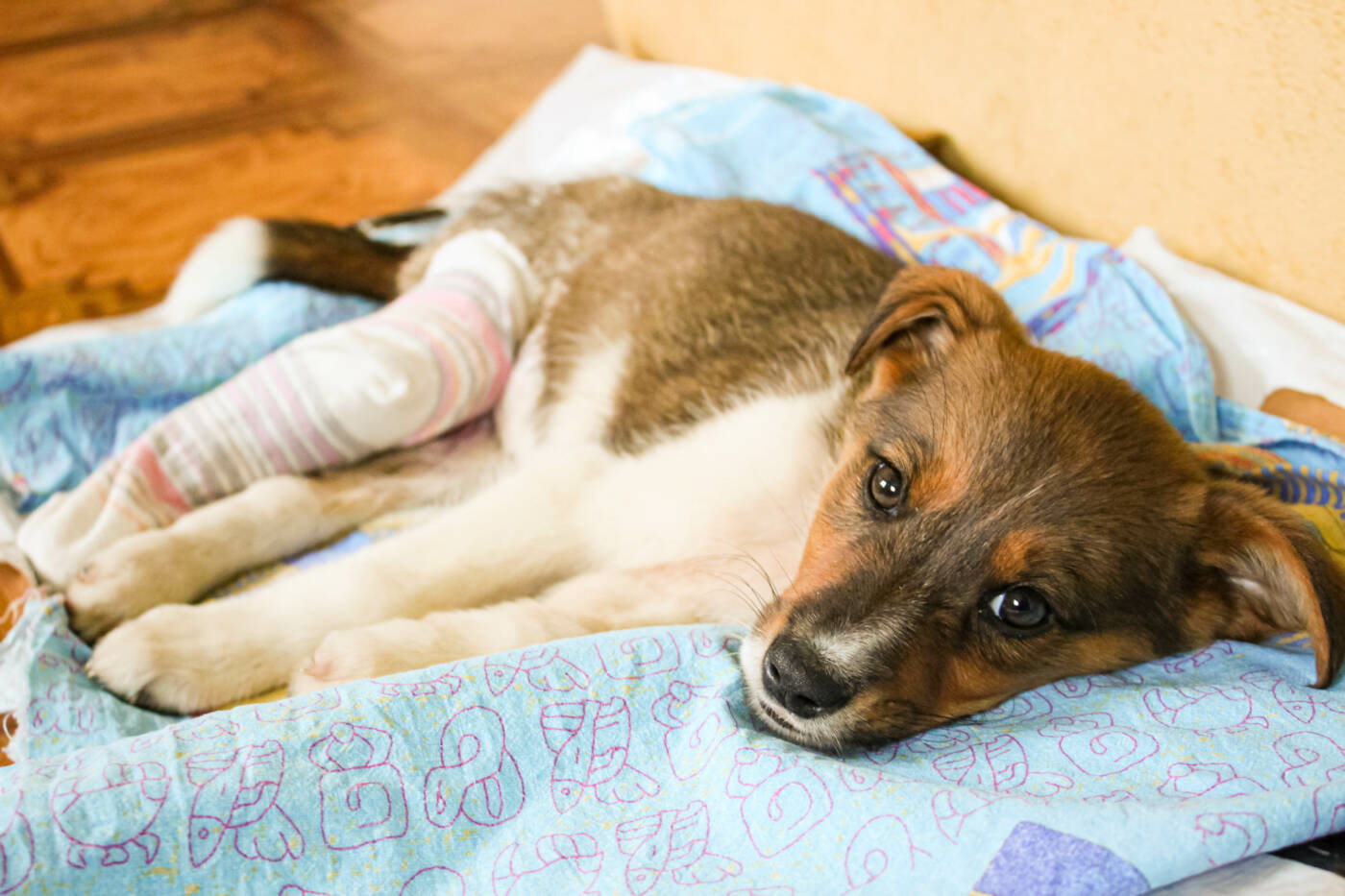Just like humans, dogs can often experience a myriad of health issues and as pet owners it is always best to be as prepared as possible for when your pet inevitably experiences an injury or issue. If your puppy has recently developed a limp, there are several steps you can take to get your canine companion back on the road to recovery as soon as possible!
Why would a puppy be limping?
If you are a new pet owner who has noticed that your puppy is limping, it is important to try to determine the cause of the limp to ensure appropriate action is taken. Limping can be caused by a number of issues or injuries, including but not limited to:
- An irritated or injured paw pad, bee sting, or foreign body in the paw
- A broken toenail
- Muscle or ligament strains or sprains
- Genetic orthopedic conditions
- Broken bones or dislocated joints and more
What should I do if my puppy is limping?
If you have noticed that your puppy is limping, there are a few steps to take to determine the best cause of actions for your canine companion. Assessing what to do for your pet’s limp will really depend on the severity of each puppy’s symptoms and can be divided into a few major categories based on these findings.
Provide Supportive Care at Home
For minor strains or sprains, providing supportive care at home may be enough for the injury to heal on its own.
If your puppy is limping, but is still able to bear weight on the affected leg and their daily activity is not impacted by the injury, providing supportive care at home may be all that is needed for your pet to recover.
Some options for providing at-home care include continued monitoring of the limp for worsening symptoms, strict exercise restriction, elevating the affected limb, and alternating cold and warm compresses to aid in healing.
Consider Veterinary Care
Patients experiencing more pronounced limping may require veterinary medical attention to assess their condition, perform diagnostics, and prescribe treatment.
Puppy patients who are not able to bear weight on the affected leg, whose daily activity is impacted by the injury, or who do not improve with supportive treatment at home after a few days, should consider seeking medical attention at their local veterinarian’s office for an assessment.
Seek Emergency Medical Care
In cases of severe or life threatening injuries, pet parents should seek emergency veterinary care at a nearby 24/7 emergency clinic or urgent care. Some indications for emergency medical treatment include:
- Visible broken bones or fractures, especially open fractures
- Extreme pain such as excessive panting, vocalizing, aggressive behavior, etc.
- Dragging the affected limb or inability to walk
- Open wounds, bleeding, or excessive swelling or bruising

What do I do if my dog is limping but not crying, no pain, and is acting normal?
If your dog is limping, but not experiencing any pain it is likely there may be an irritant or mild injury to the paw pad.
The first step would be to inspect your dog’s paw pads for any signs of irritation or injury, which may help resolve this issue. As previously mentioned, there can be several different causes of limping in dogs and puppies, but for patients experiencing a mild limp that does not interfere with daily life, monitoring and rest can generally allow the injury to heal on its own at home.
Why is my puppy limping but still running around?
If your puppy is limping, but still running around it could be that your puppy may be experiencing an adrenaline rush related to an acute injury.
When animals and people experience an acute period of high stress, the body is automatically conditioned to protect itself through a “fight or flight” response and your puppy may not realize he or she is injured until after the adrenaline wears off.
Alternatively, your puppy’s limping may be caused by a mild irritant such as something stuck to the paw, a bee sting or bug bite, etc. So it is always a good idea to start with a thorough inspection of the paw anytime limping is noticed and good from there!
How long should a limp last in a dog before it heals?
Generally speaking, if a limp is able to heal on its own at home you would notice an improvement within the first few days following the injury.
For more complicated injuries such as a broken bone or fracture, the healing process will likely require several veterinary visits along with pain management, stabilization of the leg, and exercise restrictions from anywhere between 2 weeks for sprains for around six to eight weeks for surgical repairs.
For older dogs, limping may be caused by age related changes such as arthritis or other degenerative joint diseases and improvement should be gauged by the patient’s response to medical management or palliative care under supervision of a veterinarian.
Can a puppy limp heal on its own?
Depending on the cause of a puppy’s limping, it is possible that the limp may resolve on its own with exercise restriction.
Just like people, dogs can suffer strains and sprains caused by overexertion or an injury sustained while playing. These types of injuries may cause limping but often resolve on their own. However, as a general rule of thumb, it is always best to seek the advice of your veterinarian if your puppy is experiencing severe pain, has a visible broken bone, or their limp is not improving within the first few days of rest. This is because delaying treatment in certain cases can lead to worsening injuries, chronic pain, deformities, and more.
How long will a puppy limp if it is only a sprain?
Just like people, when puppies experience a sprain or other ligament injury the body does require time to rest in order for the inflammation to resolve and the injury to heal.
Generally the injury will begin to heal within the first few days while providing at home care, but pet owners should adhere to a strict 14 day exercise restriction, as it typically takes about 2 weeks for this type of injury to heal.
During this time, your puppy should have short leash walks for eliminations, be crated or confined to a small area when not under direct supervision, and should refrain from the following activities in order to avoid worsening injury:
- Jumping on and off furniture
- Running up and down stairs
- Roughhousing with other dogs
- Any strenuous physical activity such as running, agility, etc.
How do you treat a limping dog at home?
At home treatment for a limping dog includes a multimodal approach to care.
For pets experiencing limping due a strain or sprain, this type of injury can be treated with a combination of cold and warm compresses, exercise restriction, and weight loss for certain patients.
In some cases, veterinarians may prescribe pain medications such as non-steroidal anti-inflammatories or other pain medications.
It is important to note that there are not many over the counter options for pain control in pets and owners should avoid administering any human medications such as Advil or Tylenol and these can be toxic to pets. For more serious injuries, patients may require surgery and/or physical therapy or rehabilitation as part of the healing process.
How do I know if my puppy leg is sprained or broken?
As a pet owner, it may be difficult to determine the exact cause of your pet’s injury without an assessment by the veterinarian, so it is always best to seek medical advice from a trained professional if your puppy has sustained an injury.
Generally speaking, there are a few signs to look for that may indicate a fracture of broken leg rather than a sprain, which include:
- A visible break or open fracture
- Excessive swelling or bruising of the limb
- Non weight bearing lameness
- Severe pain or dragging the affected leg
More pronounced fractures may be immediately evident whereas hairline fractures may require advanced imaging to diagnose, so it’s important to seek veterinary care if your puppy’s limp persists for a prolonged period of time.
You might like to read our post, How Far Can a Dog Fall Without Injury?
What do vets do for a dog’s sprained leg?
If your veterinarian suspects that your dog has a sprained leg, the first thing they will do is perform a thorough orthopedic exam to assess the muscles and joints of the body and pinpoint the area of injury.
Once identified, your veterinarian may recommend X-Ray imaging to check for any potential fractures, joint abnormalities, arthritis, or dislocation injuries.
Depending on the findings of your pet’s exam the doctor may recommend additional treatments such as rest, physical therapy, pain medication, and/or surgical repair.

Should I take my dog to the vet if he’s limping?
In general, it is always best to seek the advice of a trusted veterinarian whenever your pet is experiencing an illness or injury. However, if your dog’s symptoms are mild (meaning they do not interfere with daily activities), it is reasonable to start with at home care for the first one to two days and follow up with your veterinarian if symptoms persist. However, if your dog is experiencing extreme pain, you should seek immediate medical attention at a nearby vet clinic.
How much does the vet charge for a limping dog?
When it comes to vet visits, the cost for care can vary widely based on several different factors including:
- Type of veterinary care: emergency and specialty practice tends to charge much more than general practices or nonprofit centers
- Area of the country: depending on where you are in the US, the cost for care may be higher in more populated areas with greater resources
- The injury itself: the cost for your pets care will depend on the type of injury being assessed and the recommended treatment, but most vet clinics will offer a range of treatment options based on each individual client’s budget
When having your dog assessed by the veterinarian, the team will always go over an estimate for recommended treatment prior to extending services to your pet.
Many practices will cover flexible payment options such as pet insurance, healthcare credit cards such as Care Credit or Scratchpay, or payment plans. Some clinics may have reserve funds for pet owners needing assistance during an emergency, so it never hurts to ask!
Because limping can be caused by anything from a minor sprain to a broken leg, it is always best to seek a professional diagnosis to get your pet on the road to recovery as soon as possible.
If your puppy is experiencing a limp, consulting with your veterinarian is always the best option to keep your canine companion happy and healthy for years to come!




